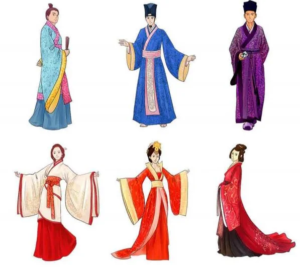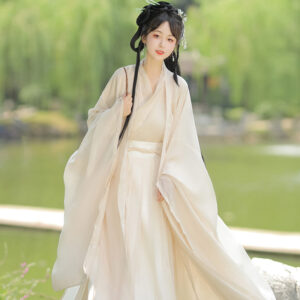

Qing Dynasty Hanfu is distinguished by its intricate designs, rich symbolism, and the blending of cultural influences, particularly from Western styles. The period saw significant changes in clothing that reflected the socio-political landscape, artistic expression, and cultural exchanges of the time.
1. Intricate Embroidery and Patterns
One of the most striking features of Qing Dynasty Hanfu is its elaborate embroidery. The garments often featured intricate patterns that conveyed deep symbolic meanings, such as:
- Dragons: Representing imperial authority and power, these motifs were exclusive to the emperor and his family. Only the royal family could wear robes adorned with five-clawed dragons, symbolizing their supreme status.
- Phoenixes: Often paired with dragons, phoenix designs represented grace and virtue, embodying a harmonious balance between yin and yang.
These motifs not only added visual appeal but also functioned as indicators of social status and rank within the rigid hierarchy of Qing society1.
2. Cultural Fusion
The Qing Dynasty was marked by significant cultural exchanges due to the Manchu conquest and increased interactions with Western nations. This cultural fusion led to notable changes in Hanfu design:
- Integration of Manchu Elements: The Manchu influence introduced new styles, such as the qipao, which eventually became a staple in Hanfu wardrobes. This blending of Han and Manchu traditions created a unique aesthetic that distinguished Qing clothing from earlier dynasties.
- Western Influences: The introduction of Western fabrics like velvet and lace enriched traditional designs. Additionally, tailoring techniques such as the stand-up collar (Mandarin collar) were adopted from Western military uniforms, marking a shift towards more structured silhouettes2.
3. Material Innovation
The Qing Dynasty saw an expansion in the variety of materials used for Hanfu:
- Luxurious Fabrics: While silk remained a staple, new materials such as wool and cotton began to appear. This diversification allowed for greater creativity in garment construction and design.
- Color Symbolism: The use of color was highly regulated; certain colors were reserved for specific social classes. For instance, yellow was exclusively worn by the emperor, while other colors indicated different ranks within society. This color coding reinforced the hierarchical structure prevalent during the Qing era13.
4. Structural Changes
The structural design of Hanfu underwent significant evolution during this period:
- Silhouette Alterations: Garments became more form-fitting compared to earlier styles. The introduction of tailored elements highlighted the body shape while maintaining traditional flowing aesthetics.
- Sleeve Design: Wide sleeves became a hallmark of Qing Hanfu, allowing for both elegance and practicality. This feature not only enhanced movement but also added to the visual grandeur of the attire4.
5. Social Stratification Reflected in Design
Qing Dynasty Hanfu vividly illustrated social stratification through its design elements:
- Imperial vs. Civilian Attire: Imperial garments were characterized by opulence and intricate detailing, while civilian attire was simpler and more practical. This clear distinction reinforced Confucian ideals regarding social order and hierarchy.
- Regulations on Attire: Strict regulations governed what individuals could wear based on their social class. These laws ensured that clothing remained a potent symbol of one’s status within society15.
Table: Key Features of Qing Dynasty Hanfu
| Feature | Description |
|---|---|
| Embroidery Patterns | Intricate designs symbolizing status (e.g., dragons for emperors, phoenixes for grace) |
| Cultural Fusion | Blending of Manchu elements with traditional Han styles; incorporation of Western influences |
| Material Variety | Use of luxurious fabrics like silk, velvet; introduction of new materials like wool and cotton |
| Structural Design | More tailored silhouettes; wide sleeves enhancing elegance |
| Social Stratification | Clear distinctions between imperial and civilian attire; strict regulations on clothing choices |
Conclusion
The uniqueness of Qing Dynasty Hanfu lies in its intricate designs, rich symbolism, cultural fusion, material innovations, and reflection of social stratification. These elements combined to create a distinctive style that not only served practical purposes but also conveyed deep cultural meanings reflective of one of China’s most influential historical periods. The legacy of these designs continues to influence contemporary interpretations of traditional Chinese fashion today.
Share this post
Recent Posts


What were the key features of Hanfu during the Tang Dynasty?

How did Hanfu styles vary during different Chinese dynasties?

What accessories are typically worn with Hanfu?

How do you choose the right Hanfu for different seasons?

Newsletter
Popular Categories
Related Post
Sed aliquam, tortor et sodales malesuada, lorem leo luctus tellus, quis interdum eros nibh in nunc. Cras dignissim malesuada, lorem leo luctus

What are the winter hanfu called?

What were the key features of Hanfu during the Tang Dynasty?

How did Hanfu styles vary during different Chinese dynasties?


